Halo Wars 2 PvP beginner's guide
Halo Wars 2 can often be a confusing experience for new players to try and learn. Here's a basic guide on the fundamentals of Halo Wars 2 to help improve your skills on the player versus player (PvP) battlefield.

Halo Wars 2 is the latest installment in the Halo Wars real time strategy (RTS) spinoff series, and Halo's first person shooter fan-base looking to get good at the new Halo title may struggle to find success in this genre of game. To help new players to the RTS genre out, we created a comprehensive guide to understanding the basics of Halo Wars 2, and we came up with an array of tips and tricks for you to try out in-game against your opponents.
In this guide, we're going to cover the following:
- Unit types.
- Resources and economy.
- Leaders and their abilities.
- Structures, tech levels, and unit upgrades.
- Tips and tricks.
Let's build some bases, select all units, and dive straight in to the fundamental basics of Halo Wars 2.
Unit types
One of the most important things to understand in Halo Wars 2 is the different unit types. There are three basic classes of units: infantry, vehicles, and aircraft. The core units of these classes operate on a basic rock-paper-scissors principle — infantry beat aircraft, vehicles beat infantry, and aircraft beat vehicles. However, all units from all three classes can be broken down into several subgroups.
Core units

Core units are the jack-of-all-trades units that form the backbone of most armies. They excel at doing moderate damage to all targets that they don't have a type disadvantage against. Some examples of core units are Marines, Wraiths, and Hornets. However, core units will struggle against units that outmatch them in the rock-paper-scissors engagement that I mentioned above, or against counter units. Core vehicle units like Scorpion tanks will decimate squads of core infantry Grunts, and anti-aircraft Wolverine vehicles will destroy Banshees.
Counter units
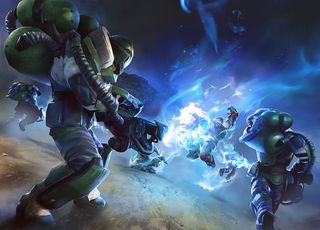
Counter units focus on dealing with one specific type of target. Locusts, a Banished vehicle, do heavy damage to enemy bases and fortifications, while Hellbringer troopers melt infantry with their flamethrowers. However, this specialty comes with a tradeoff; counter units perform poorly against any other type of unit. The aforementioned Hellbringers barely scratch the health bar of tanks, to name one example. Generally, you'll want to have an army that mainly consists of core and counter units so that you can still effectively combat units that your counter units aren't suited to engage.
Scout units
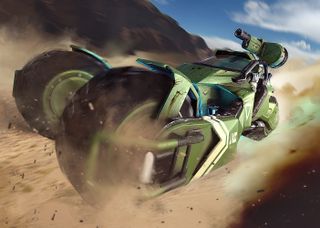
Scout units are light vehicles that move across the field extremely quickly. Cheap to produce and generally weak in combat, these units are extremely useful not for fighting, but instead for scouting around the map and keeping an eye on what your enemy is building. In general, you will always want at least one scout out in the field to gather intel on your opponent. This info will be critical when choosing what type of counter units to build. If you drive your scout by the enemy base and see tanks, you'll know to make anti-vehicle units, for example. These units are also excellent at collecting resources spread out around the map.
Get the Windows Central Newsletter
All the latest news, reviews, and guides for Windows and Xbox diehards.
Support units

Support units are a broad subclass of units that can offer a multitude of combat support benefits depending on the support unit you have. Ranging from healing abilities to camouflaging units to providing artillery support, having a few support units in your army can make the difference between winning or losing an engagement.
For example, having some Kodiak artillery pieces set up on high ground firing shells down into a clustered group of infantry or vehicles can help soften up the enemy for your own army to pick off. Healing units can offer sustainability to your forces, allowing your troops to recover lost health during and after a fight. Units that can cloak other units can help make surprise attacks that much more surprising.
Super units
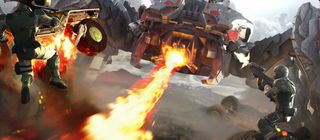
Super units are the strongest type of unit in Halo Wars 2. Sporting massive production costs, and requiring a high tech level, these units can turn the tide of a battle with their massive damage capabilities and ability to soak up damage. However, they are not without weaknesses. Super units are very slow and have to be positioned carefully in order to avoid getting surrounded. In addition, super units still suffer to counter units. Scarabs will still take increased damage from anti-vehicle forces, and Condor gunships are weak to anti-aircraft fire.
For these reasons, it's best to deploy super units alongside a force of support units, as well as counter units that are strong against whatever units the enemy has that the super unit will struggle against. One example of a combination you could do is having a Scarab with Elite Rangers to kill enemy Cyclops anti-vehicle units, and Engineer support units to heal both the Rangers and Scarab.
Hero units
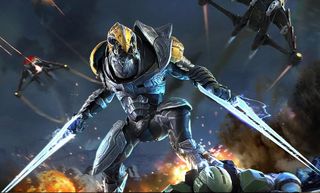
Hero units are special types of units that are unique to each Leader. They are independent of the standard population limit, and as such, every army can always have a hero unit in it, regardless of whether the population is full or not. Every hero has special abilities that make both them and their allied units stronger than usual, and some possess some passive abilities as well. Some hero units are better than others in certain situations (for example, Arbiter Ripa 'Moramee is great at killing infantry, while the Hunter Captain is strong against vehicles) but all of them are useful assets on the field.
Resources and economy
Now that you know about all of the unit types in Halo Wars 2, let's go over the way in which you obtain them.
There are two types of resources that you need to produce and manage in order to effectively create an army: supplies and power. Supplies can be found around the map in blue crates, which units can collect. In addition, they can be produced from Supply Pad (UNSC) or Harvester (Banished) structures on your bases. Power is a bit trickier. Similar to supplies, you can find power crates around the map, and you can also make Power Generators (UNSC) or Power Extractors (Banished) to produce power.
However, the power buildings generate power much slower than their supply building counterparts. To harvest a large amount of power quickly, you'll need to capture Power Nodes that are spread throughout the map. These will generate power for everyone on your team, lessening the need for more power structures. However, the enemy can take them from you, so they must be protected.
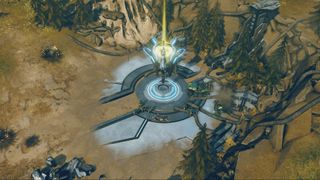
The two resources described above fulfill different roles in your economy. Supplies are used when constructing bases and structures, while power is used to purchase upgrades for units and structures. When building units, both power and supplies are used, though the unit requires more supplies than power. To maintain a good economy so that you never run dry on resources, it's important that you capture and hold as many Power Nodes as you can, and have a steady income of both resources coming from structures on your base. Always make sure to upgrade these buildings to double the rate of resource gain!
Leaders and their abilities

An important aspect of Halo Wars 2 is understanding the concept of Leaders. Leaders are the commanders of the UNSC or the Banished that the player controls in each game. Each Leader possesses different benefits and abilities. For example, Captain Cutter is the only leader capable of using ODSTs, while Atriox has the power to make his units temporarily invincible.
Understanding what every single leader has in their tool belt is something you should know, so make sure you read the description of each leader in the menus. Generally, you'll want to pick the Leader that best suits your style of play. For example, if you like stealth and surprise attacks, the Shipmaster would be a good choice because of his cloaking and teleporting bonuses.You should pay attention to what your selected Leader offers in terms of unique benefits (as well as hero units). Leader powers and abilities are accessible by holding left trigger. From there, you can choose which ones to use. Good usage of Leader powers can win battles, so make sure to use them when you feel the time is right.
Structures, tech levels, and unit upgrades

\
Structures form the backbone of your economy and unit production. These are buildings that are all constructed around a base. Bases have several modular building slots around them, giving you the freedom to choose what buildings go where around the base. They are high in hit points, although anti-building units will destroy them faster than other units do. Here are all of the types of buildings:
- Resource buildings — Buildings that bring in supplies and energy.
- Armory/War council — Building that lets you build and upgrade Hero units, build Super units, upgrade building health across all bases, and upgrade population size and unit production speed.
- Barracks/Raid camp — Building where infantry is built and upgraded.
- Factory/Foundry — Building where vehicles are built and upgraded.
- Airpad/Apex — Building where aircraft are built and upgraded.
In addition, you can also construct turrets, shield generators, artillery cannons, or cloaking devices in the turret slots on bases. These defenses will augment your defending army in the event of an assault.
Tech levels
To increase the strength of your units and to get stronger types of units, you'll need to upgrade your tech level. This is done by upgrading the central structure on a base. Thankfully, if you unlock a tech level on one base it will unlock that tech level across all bases, so you don't need to upgrade every base if you don't want to. However, upgrading bases also opens up more slots for buildings, so it may be worth doing if you have resources to spare.
Unit upgrades

To make your forces stronger, you'll need to upgrade them. Depending on the upgrade, existing and new units will gain more health, new abilities, or new damage values. As I've already discussed, you need power and a high enough tech level in order to research an upgrade. Depending on the type of upgrade, researching one could take anywhere from 15 seconds to a full minute and a half. Upgrading your units is critical; if your basic army faces an upgraded force, your chances of survival are slim. Make sure that you get upgrades whenever you have the resources and time to do so.
General tips and tricks
- Try to keep your army moving around. A mobile army is a safer army, and enemy units may miss moving targets.
- Try not to bunch up all of your units. Spreading them out allows you to avoid having your entire army wiped out by strong area-of-effect Leader powers.
- Take the high ground whenever you can. Units on higher ground can see and shoot farther than normal. Artillery units in particular are devastatingly effective if put on high ground.
- Putting infantry units in garrisons allows them to do more damage, see farther and take more punishment. Hero infantry units in garrisons can feel impossible to kill, so don't pass up the opportunity to do so.
- Aircraft can cross terrain that vehicles and infantry can't. Use aircraft in these situations to gain a mobility advantage on the enemy.
- Work together with your teammates in 2v2 and 3v3 to create a coalition of units that cover all bases. A diverse army has a much higher chance of success than three full armies of one unit type.
- Targeting support units first in a battle is a good idea. By killing them first, you can take away the benefits they offer to the rest of the enemy army.
- Never focus fully on upgrading tech and researching unit upgrades. It's always good to have units in the field to establish map control, especially early on.
Get out there and show them what you're made of!
Now that you've learned the ins-and-outs of Halo Wars 2, go play some PvP and get some experience. While this guide gives you all the essential info, the only thing that will make you a great player is practice and patience. In the event that you don't own Halo Wars 2 ($30) yet, make sure to pick it up soon and bring your tactical skills to the Halo battlefield!
Brendan Lowry is a Windows Central writer and Oakland University graduate with a burning passion for video games, of which he's been an avid fan since childhood. You'll find him doing reviews, editorials, and general coverage on everything Xbox and PC. Follow him on Twitter.

